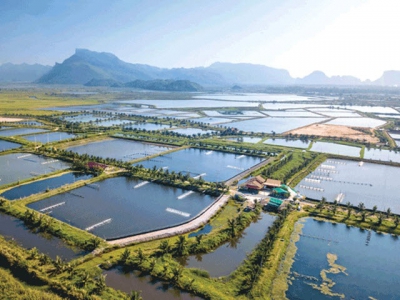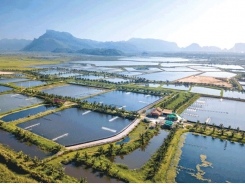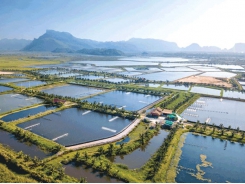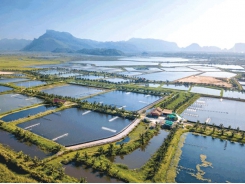Land Based Sustainable Aquaculture Strategy - Part 4

6/ Site Selection
Introduction
Selection of an appropriate aquaculture site is paramount to the success of the venture. Appropriate site selection can avoid the need for environmental mitigation measures and costly ongoing management, operational and monitoring procedures. Whether the land is already owned or the property is to be purchased, the following should be considered:
- Aquaculture must be a permissible land use and compatible with nearby land uses. The site must not be affected by near-by agricultural pesticide use or be constrained by potential adverse affects on adjacent residents.
- Site specific investigations should indicate that the site is fundamentally suitable for an aquaculture operation. Consider the supply of water (quality & quantity); soils suitable for pond construction; a climate suitable for the culture species; enough land to manage waste water or means of disposal via municipal infrastructure; proximity to power; suitable land slope for construction, minimisation of pumping costs and managing waste; proximity to markets, service providers, supplies and manpower (all can impact adversely on operational costs).
A site-specific investigation and evaluation, commensurate with the size and complexity of the proposal is required. The evaluation will consider all relevant legislation, plans and government policies (eg. in relation to river and estuary flows regimes, water allocation, floodplain management, vegetation management, zoning, heritage strategies, potential land use conflicts, acid sulfate soils, biodiversity protection, etc). In general, the selection of a site should be based on a thorough knowledge of local and regional hydrology, geology, topography, ecology and climate. Although environmental factors are critical when assessing sites other factors such as land and construction costs need to also be considered.
The project profile analysis chapter of this document provides a systematic and rigorous ‘sieve’ approach to site selection. Government agencies will use this approach when formally assessing a proposed aquaculture venture.
Firstly assessing a project or location against the project profile analysis model will help determine whether your proposal meets minimum mandatory performance criteria. If it does, then the process, in conjunction with the information in this strategy, will help assess how the proposal will be classified from low risk to higher risk.
Information in this strategy provides detail to be considered when undertaking a project profile analysis.
Estuarine aquaculture sites
Assessment of estuarine aquaculture sites should refer to the NSW Government’s sea level rise planning benchmarks, relevant coastal zone management plans and address issues related to inundation, water quality, drainage and acid sulfate soils (ASS) which could impact on the long-term viability of aquaculture on the sites.
To provide assistance in identifying potential sites for saline pond aquaculture within estuarine areas of NSW, maps have been prepared for 12 northern NSW estuaries (see appendix 1). These areas are:
1. Tweed River Estuary
2. Brunswick River Estuary
3. Richmond River Estuary
4. Clarence River Estuary
5. Bellinger and Kalang River Estuaries
6. Nambucca River Estuary
7. Macleay River Estuary
8. Hasting River Estuary
9. Camden Haven River Estuary
10. Manning. River Estuary
11. Port Stephens including Myall and Karauh rivers.
12. Hunter including Hunter, Patterson and Williams Rivers.
These maps have been developed using GIS information and identify potential locations based on attributes including:
- elevation above Australian Height Datum;
- spatial salinity for the estuary and bathometry assessment;
- acid sulfate soil profile;
- land use zoning;
- conservation exclusion zones.
Although maps have only been prepared for the above estuarine areas, saline pond aquaculture is potentially suitable within other NSW estuaries provided the site meets the minimum locational performance criteria.
It should be noted that the 12 estuarine aquaculture maps were compiled based on data available at the time of production and only represent areas that may have potential for aquaculture. Detailed site assessment as outlined in this chapter is still required and current LEP and other mapping information may need further investigation.
Because of the extent of locational possibilities for freshwater tank, raceways and ponds, a detailed mapping approach to identify potential freshwater aquaculture sites has not been undertaken.
Related news
Tools

Phối trộn thức ăn chăn nuôi

Pha dung dịch thủy canh

Định mức cho tôm ăn

Phối trộn phân bón NPK

Xác định tỷ lệ tôm sống

Chuyển đổi đơn vị phân bón

Xác định công suất sục khí

Chuyển đổi đơn vị tôm

Tính diện tích nhà kính

Tính thể tích ao




 Land Based Sustainable Aquaculture Strategy - Part 5
Land Based Sustainable Aquaculture Strategy - Part 5  Land Based Sustainable Aquaculture Strategy - Part 3
Land Based Sustainable Aquaculture Strategy - Part 3